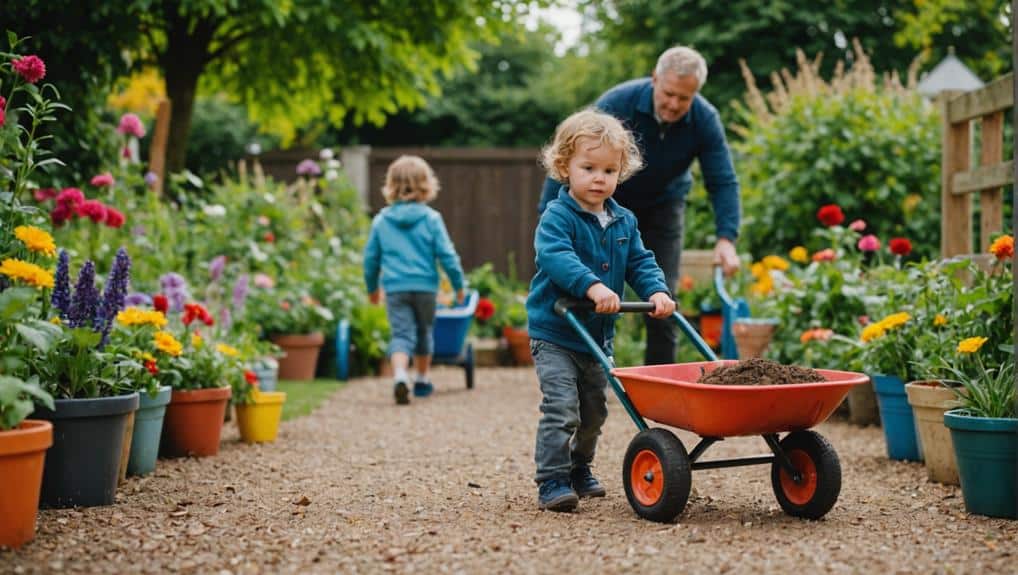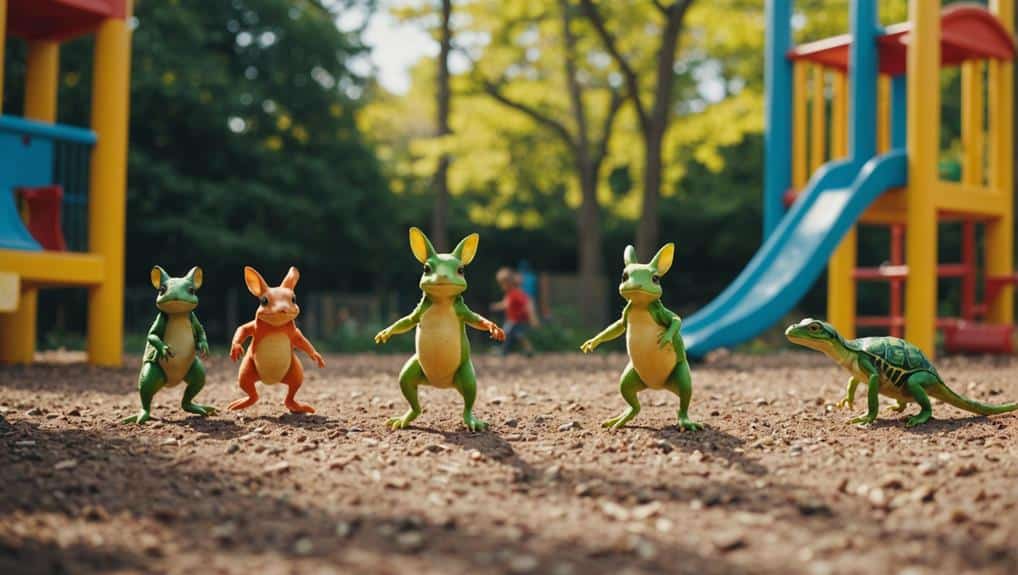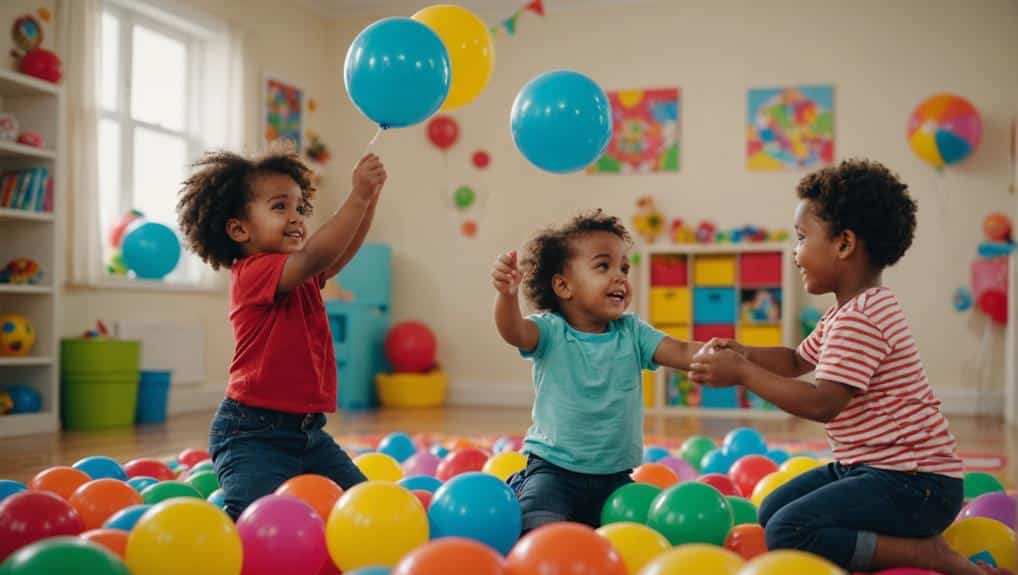Key Takeaways
- Hopscotch can improve balance, coordination, and precision while enhancing cognitive skills.
- Creating obstacle courses can promote problem-solving skills and physical confidence and enhance balance.
- Wheelbarrow walks are fun for building arm and core strength and developing balance and coordination.
- Trampoline bouncing actively engages core muscles, contributing to the development of balance, coordination, and agility.
Have Fun Boosting Motor Skills
Engaging toddlers in the classic game of hopscotch and various ball-play activities remarkably enhances balance, coordination, and hopping skills, providing a fun and interactive method of motor skill development. The physical movement involved in hopscotch promotes agility and precision, as children need to land in specific squares. This actively engages and strengthens leg muscles, fostering motor accuracy and improving overall physical coordination.
Hopscotch also presents an engaging way to practice numbers and counting, integrating cognitive skill enhancement with physical development. The game can be easily adapted to indoor environments, making it a versatile tool for motor skill development. For instance, a hallway hopscotch setup using painter’s tape offers an excellent indoor alternative for active play.
With each hop, jump, and skip, toddlers gain confidence in their ability to balance and coordinate their movements, enriching their playtime experience. Hopscotch serves as more than just a game. It is a developmental tool that helps toddlers enhance their motor skills in a fun, interactive manner. Encouraging such activities keeps the focus on the child’s holistic development while providing support for their growth and well-being.
Enhancing Coordination Through Obstacle Courses
Obstacle courses present a diverse approach to enhancing gross motor skills in toddlers, especially in boosting their coordination. Incorporating physical challenges such as crawling, jumping, and balancing, they foster the development of balance and spatial awareness. Setting up these courses at home and encouraging toddlers to navigate them promotes problem-solving skills and physical confidence.
Obstacle Course Benefits
Moving through different physical obstacles in obstacle courses effectively enhances toddlers’ coordination, balance, and agility. This physical activity is more than just fun; it is a strategic method of developing gross motor skills in a controlled and focused environment.
The benefits of an obstacle course extend beyond the immediate physical advantages. As toddlers navigate various challenges, they cultivate cognitive skills such as problem-solving and decision-making. Each task on the course requires them to assess the situation, make a plan, and then execute it. This process instills confidence in their abilities and boosts their self-esteem.
Furthermore, obstacle courses can be tailored to target specific gross motor skills, such as jumping, crawling, or climbing. This allows caregivers and educators to focus on areas of development that may need more attention. Regular participation in such physical activities can lead to overall physical development, increasing the child’s productivity levels and promoting a healthy lifestyle from a young age.
Setting Up Courses
Now that we’ve established the benefits of obstacle courses let’s explore how to effectively set them up to enhance coordination and other gross motor skills in toddlers. Setting up courses is an engaging way to promote motor skill development. You can easily set up these courses at home or in your backyard, making them a convenient tool for boosting your child’s physical abilities.
When setting up courses, consider incorporating a variety of obstacles. Tunnels encourage crawling, which strengthens the muscles in the arms and legs. Balance beams and stepping stones can improve balance and spatial awareness as toddlers carefully navigate them.
The beauty of obstacle courses lies in their adaptability. You can adjust the complexity of the course based on your skills and confidence level. As they gain mastery, incrementally increase the challenge to keep their motor skill development progressing.
Building Strength With Wheelbarrow Walks

Wheelbarrow walks are an engaging exercise that effectively builds arm and core strength in toddlers while fostering the development of their gross motor skills. The activity targets specific muscle groups and enhances coordination, balance, and physical endurance. Integrating this playful exercise into a child’s routine can significantly improve physical development and strength.
Wheelbarrow Walks Benefits
The benefits of wheelbarrow walks in boosting a toddler’s core strength are significant, as this engaging activity not only enhances physical endurance and upper body muscle development but also fosters coordination by requiring one child to walk on their hands while another supports their legs. This remarkable exercise, designed for toddlers, is a fantastic way to enhance their gross motor skills while also promoting physical development.
Wheelbarrow walks contribute to the following:
- Muscle Development: By placing weight on the arms and engaging the core, toddlers build strength in these areas, laying the foundation for future physical activities.
- Balance and Coordination: Walking on hands while being supported requires high coordination and balance, essential skills in a child’s development.
- Endurance: Regular participation in wheelbarrow walks can increase a toddler’s physical endurance, promoting a healthy, active lifestyle from an early age.
Setting Up Wheelbarrow Walks
Incorporating wheelbarrow walks into toddler playtime demands careful planning and supervision. Wheelbarrow walks lay a solid foundation for building arm and core strength, enhancing upper body muscles, and boosting physical endurance in young children. As an engaging and enjoyable activity, wheelbarrow walks can be the perfect addition to your toddler’s routine.
Adults must provide the proper support and supervision to ensure the activity’s effectiveness and safety. Begin by holding your child’s gs or hips, gradually reducing the support as they gain confidence and strength. This activity should be carried out on a soft surface such as grass or a carpet to prevent potential injuries.
Wheelbarrow walks not only build balance but also enhance coordination skills in toddlers. With regular practice, toddlers can develop more muscular arms and core muscles, crucial for other physical activities. Furthermore, these walks can help improve physical endurance, preparing their bodies for more complex tasks as they grow.
Improving Balance With Trampoline Bouncing
Trampoline bouncing can enhance toddlers’ balance by stimulating their core muscles and fostering better coordination. This fun activity also develops balance control and provides essential sensory input. When toddlers jump, their bodies have to adjust to the shifting center of gravity, which helps improve their sense of balance and spatial awareness.
Trampoline bouncing offers several key benefits:
- It engages core muscles, helping children to maintain balance and coordination.
- It provides sensory input, significantly benefiting children with sensory processing issues.
- It promotes physical fitness, with regular sessions contributing to gross motor skills and agility.
The social aspect of trampoline bouncing should not be overlooked. Supervised trampoline use encourages peer interaction and can foster a sense of community among toddlers. It also promotes a healthy, active lifestyle from a young age. Caregivers can nurture their gross motor skills by incorporating trampoline bouncing into a toddler’s routine while making fitness fun and enjoyable.
Encouraging Creativity Through Animal Movements

While trampoline bouncing considerably enhances balance and coordination, another effective and enjoyable method of strengthening gross motor skills in toddlers is through imaginative animal movements. These activities, which allow children to pretend to be frogs, bears, or other creatures, promote creativity and imagination while simultaneously developing essential physical skills.
Involving animal movements in playtime is fun and engaging for toddlers and fosters physical development, core strength, and overall coordination. For instance, mimicking a frog can enhance leg strength and balance, while pretending to be a bear on all fours can improve arm movements and coordination.
Here are some examples of how different animal movements can promote motor skills:
| Animal | Motor Skill Enhanced |
|---|---|
| Frog | Leg strength, balance |
| Bear | Arm movements, coordination |
| Kangaroo | Core strength, coordination |
Promoting Teamwork With Tug of War
Harnessing the competitive spirit of tug-of-war, this exciting activity promotes teamwork and cooperation among toddlers. It dramatically strengthens arm and core muscles, contributing to developing gross motor skills and overall physical strength.
To make the activity more effective, consider the following:
- Confirm that the rope is suitable for the toddlers’ zeal and strength. The rope should not be too heavy but provide sufficient resistance to challenge their muscles.
- An adult should supervise the game to ensure safety and encourage fair play.
- Introduce the concept of teamwork and cooperation before starting the game. Emphasize the importance of working together to achieve a common goal.
Tug of War is not just about winning; it’s about teaching toddlers the value of cooperation and teamwork. It enhances their gross motor skills, builds physical strength, and improves coordination. Most importantly, it makes learning fun for them. So, let them pull, tug, laugh, and learn all at the same time.
Hand-Eye Coordination With Balloon Volleyball

To enhance hand coordination in toddlers, consider balloon volleyball, a game combining physical activity and playful learning. This fun indoor game sparks children’s interest and aims to refine their motor skills. With its erratic movement patterns, Balloon volleyball provides an excellent platform for toddlers to develop their gross motor skills and hand-eye coordination.
A game of balloon volleyball goes beyond fun and games; it’s an effective method of enhancing core strength in young learners. As toddlers reach, strike, and chase the gently floating balloon, they engage their muscles, promoting core strength and overall physical development. More importantly, this game encourages toddlers to actively participate in physical activity, a critical aspect of their growth and development.
Balloon volleyball can easily be adapted for toddlers with varying skill levels, providing an inclusive environment for all participants. Moreover, it offers opportunities for social interaction, aiding in developing communication and cooperation skills. Thus, balloon volleyball is not just a game but a versatile tool for fostering gross motor skills, hand-eye coordination, and core strength in toddlers.
Increasing Agility Through Ball Games
Moving on from balloon volleyball, another practical approach to strengthening gross motor skills in toddlers is through ball games such as soccer, basketball, and catch. These engaging activities offer enjoyable experiences and improve skills like coordination, core strength, agility, and spatial awareness.
Ball games are specifically designed to:
- Improve coordination and balance: With repeated practice, toddlers learn to control their body movements, enhancing hand-eye and foot-eye coordination.
- Develop core strength and agility: Kicking, throwing, and catching the ball requires a significant amount of exertion, thereby developing toddlers’ strength and agility.
- Increase spatial awareness: While playing ball games, toddlers learn to judge distance and direction, enhancing their spatial awareness.
Frequently Asked Questions
Encourage your toddler’s motor development through engaging activities. These can include hopscotch, trampoline bouncing, and animal movements. Obstacle courses, balloon volleyball, and games like Simon Says can also effectively boost coordination and balance.
What Activities Can Help Develop Gross Motor Skills?
Engaging toddlers in hopscotch, obstacle courses, and animal movements can significantly enhance their gross motor skills. Games that foster hand-eye coordination, like balloon volleyball, promote physical development and interactive play.
Which Play Activity Is Best Suited to the Toddler’s Goss Motor Skills?
The best play activity for honing toddlers’ motor skills largely depends on their unique preferences and developmental stage. However, a mix of obstacle courses, playground play, and target-hitting games is generally beneficial.
How do you encourage a child’s motor skills in their first two years?
Engage children in activities like block stacking, object grasping, and tummy time to best encourage their motor skills during their early years. Also, sensory experiences like sand and water play should be introduced for balanced development.


Recent Comments